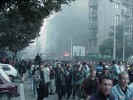Srebrenica: The Mythological Massacre
3 Years Later, And Still Searching
By George Pumphrey
Note: this article argues that the Srebrenica massacre was a fiction told to
isolate the the Bosnian Serb Army and justify NATO attacks. At the end you'll find links
to other articles which expose NATO genocide stories used to justify the recent bombing of
Yugoslavia.
The third anniversary of the takeover of Srebrenica by Bosnian-Serb troops on July
11, 1995 has come and gone. The significance of this takeover determined not only the
outcome of the Bosnian civil war, but reached far beyond the Balkans.
It was the events around Srebrenica, and the subsequent indictments against the
Bosnian Serb political leader, Radovan Karadzic and the Bosnian Serb military Commander,
Radko Mladic on charges of genocide and crimes against humanity, that changed the
political constellation at the negotiation table at Dayton. With its leadership under
indictment, the Bosnian Serb side had to content itself with being represented by Slobodan
Milosevic, president of a, by then, foreign state.
The fact alone of an international tribunal being given jurisdiction over people
and events taking place thousands of miles from the contexts of those sitting in
judgement, without an existing set of legal norms creates already a new basis for the
concept of "justice." Srebrenica has been the main source of this tribunal's
credibility and its raison d'être.
As in the past two years, this year also the war crimes tribunal has sent out
teams to search for mass graves containing the remains of the 8,000 Muslim soldiers that
are widely believed to have been massacred in the aftermath of the takeover. But a closer
look at the background of the Tribunal's search sheds a bit of light on the shadowy side
of the Tribunal's work.
The New York Times published an article written by one of its correspondents, Mike
O'Connor, (republished in the International Herald Tribune May 14, 1998) entitled
"Mass Graves in Bosnia Bolster War-Crimes Cases." This article is very helpful
in examining the work of the Tribunal in The Hague, which is why it will be extensively
quoted.
Deep in a remote rural stretch of Bosnia, war-crimes investigators have found a
tangle of buried bodies that they say is the remains of some of the 7,500 Muslim men that
were hidden to try to thwart the prosecution of Bosnian Serb leaders for genocide. (...)
Exhumations in 1996 recovered 460 bodies, but 7,500 others were still missing from the
town of Srebrenica. Finding the others has been the goal of war-crimes investigators for
more than two years.
(...) The discovery Tuesday - and the thousands of bodies that investigators
expect to find nearby - will bolster the cases against 2 Bosnian Serb leaders, Radovan
Karadzic and General Ratko Mladic, the investigators say. Both have been indicted for
genocide by the tribunal in The Hague.
Investigators for the tribunal spoke Tuesday on condition of anonymity.
Satellites that can locate bodies decomposing underground, according to foreign
military officers working with the tribunal, aided the search. Witnesses to the reburial
also offered testimony, tribunal officials said.
The first remains were uncovered Tuesday morning. Investigators unfurled a thin
silvery sheet to protect their find from the sun. Next to it, small orange flags had been
stuck in the ground to mark pieces of evidence such as bits of clothing or shell casings.
Tuesday evening, according to a tribunal official, a layer of tangled bodies
across an areas of 200 ft² (18 m²) had been exposed. The bones were so intertwined, the
official said, that it was not possible to exhume any of them Tuesday.
Proving that the soil around the bodies came from the original mass graves, or
that shell casings found here match those found at execution sites, will establish the
connection they are looking for, investigators said.
When the original sites were inspected in 1996, investigators suspected most of
the bodies had been moved. Doubts were cast on American military's satellite surveillance,
with some investigators charging at the time that slipshod monitoring had allowed Bosnian
Serb authorities to move the bodies undetected.
Now, however, tribunal officials say the bodies were moved in October 1995, before
the pinpoint satellite surveillance was requested by the tribunal. Once the original sites
were discovered to have been tampered with, American satellite photographs of the region
were reviewed and were found to show trucks and earth-moving equipment at the original
burial sites, according to tribunal officials.
Anonymous investigators say that the find "will bolster the cases against
[the] two Bosnian Serb leaders." The question should be raised: on what basis did the
tribunal make its charges of no less than "genocide," if they now have to
frantically run around to scrape up enough bodies to make their indictment plausible? If
they now have to try to "prove that the soil around the bodies came from the original
mass graves," does it mean that what they had considered to be "the original
mass graves" were either empty or with too few bodies to justify the indictments?
Were Karadzic and Mladic charged according to the principle: "Indict now. Look for
evidence of a crime later"? "Charge the Serbs! If you don't know what for, they
do" seems to be the modus operandi in The Hague.
But it was this widely publicized "genocide" indictment that has caused
irreparable damage to the political and social constellation in this region of Europe,
creating also a new set of political factors in the world. Some of them are:
the discrediting of the United Nations for having supposedly allowed a
"genocide" to take place on territory under its authority; promoting NATO as the
new "peace keeping" force; making great strides to create public acceptance for
inquisitorial, McCarthyist standards both in "justice" and
"journalism" on both national and international levels; the definition of a new
"moral" standard based on "human" rights, determined by membership in
particular "ethnic" groups with rights to be respected and all others without
rights worthy of respect; growing international acceptance of the concept of a people
being classified per se as "evil." This has all been made possible through a
massive propaganda campaign colporteuring a - yet to be proven - "genocide," as
if it were a certitude. Politicians have justified and based momentous decisions upon the
supposition that the massacre is fact, decisions determining the welfare of the peoples of
this region and beyond.
The media bases each succeeding generation of falsification on preceding
generations of unproven factors. Both are so often repeated as a certainty, that the
public does not even demand substantiating evidence.
O'Conner writes that "7,500 Muslim men were hidden to try to thwart the
prosecution of Bosnian Serb leaders for genocide. 'Their' bodies were moved in October
1995, before the pinpoint satellite surveillance was requested by the tribunal."
These and other allegations are in gross contradiction to other information published in
the press.


